Shearing Stress - Definition, Meaning, Units, Formula, FAQs
The internal resistance induced in a material per unit cross-sectional area when subjected to an external load is known as stress. Shear or shear stress in mechanics is the force generated due to the sliding of the one layer of object over the other. In simple term shear stress meaning or what is shear is the wearing of the material due to tangential forces applied per unit area. It is well known fact that when the load is applied on the any object it undergoes the deformation.
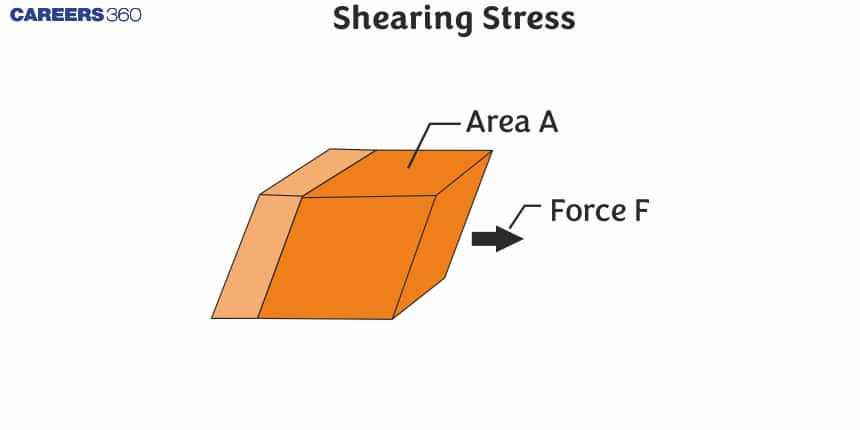
When the force applied is in the direction of the plane of the object, the deformation of the object is along that plane. Due to this force object experiences the stress called as the shear stress or tangential stress. Shear stress induces the shear strain in material. Shear stress is denoted by Greek letter τ (tau). Its magnitude is calculated as the internal resistance (shear force) divided by the area resisting the shear force. The shear force definition is that the force that produces the tangential wear or tangential deformation in material is called as the shear force.
Shear stress definition?
When a load is applied directly to the bar, the length of the bar (L) changes . The strain generated when the original length of the bar is L Changes by dLs and the ratio of the change in length to the original length is call as strain: Strain is thus a measure of material deformation and is a dimensionless quantity. That is, there are no units. It is simply the ratio of two quantities with the same unit.

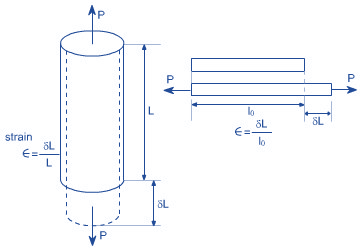
Shear Stress =Shear Force/Cross-Section Area
τ=F/A
It is also called shear force formula
Strain ϵ= δL/L Shear strain formula
Above equation is shear stress formula. Shear stress units or Shear stress unit is N/m2
Shear strain unit- dimensionless
Different Units of the Shear Stress
System of units | Stress units |
Fundamental units | Kg.m-1.s-2 |
SI (derived units) | N/m2 |
SI (derived units) | Pa or pascal |
SI (mm)(derived units) | M.Pa or N/(mm)2 |
US unit (ft) | lbf/ft2 |
US unit (inch) | Psi (lbf/inch2) |
Also read -
what is shear strain?
In simple term shear strain produces angle change in objects.
This shear deformation or slip can be defined as a change in right angles Or the angle of strain is called shear strain. Shear strain is measured in radians, so it is dimensionless, that is, it has no units.
Shear deformation is calculated as the displacement from the objects unique position of the surface in direct contact with the applied shear stress.
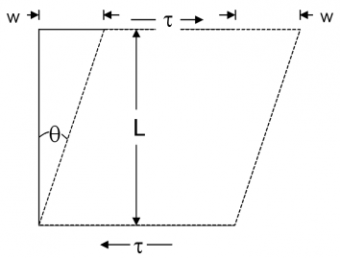
ϒ=wL = tanθ≈θ
Shearing Strain in Real Life
The second you awaken and move slowly at the mattress to get out of the mattress, until you move returned to sleep. Almost each example of the everyday pastime contains shear stress.
Some of such real-lifestyles situations are indexed below-
- All types of Slicing and Cutting (Cutting fruits, vegetables, paper, cloth, tree etc)
- Painting, Brushing, Applying creams/soaps/lotion/ointment etc. While Chewing meals among the teeth’s.
- While strolling or strolling whilst our feet push floor returned to transport forward.
- When a transferring automobile begins offevolved or stops, The floor of the seat revel in the shear stress.
- When water flows River beds revel in shear stress.
- Sometimes due to shear strain erosion may be noticed.
- On the phone monitors whilst sliding.
- While making ready Indian bread like Dosa, Roti, Pizza base etc.
- Polishing the floor. Writing on blackboard with chalk piece On sliding etc.
Related Topics Link, |
Material properties in shear – shear stress modulus
The relationship between shear stress and shear strain, and also between normal stress and axial deformation, is determined by experiments in labs.. Experiments show the linear characteristics of materials within elastic limit, the stress / strain ratio is determined by the expression:
τ= Gϒ
where G is the “modulus of shear “of the material. Note that shear modulus is in units of force per unit area (for example, lb / in2 = psi and N / m2 = Pa). The shear properties of linear elastic materials are closely related, in particular, the following relationship can be derived:
G = E /2(1+ v)
Here, E is Young's modulus and ν is the Poisson's ratio.
Stresses on Axially Loaded Members
Consider the stresses in an axially loaded bar with a cross-sectional area A. Here we will cut the bar perpendicular to the bar axis as shown below.
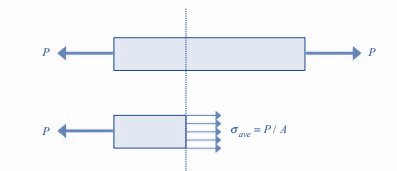
Considering load P is acting on entire bar of length L , then it can be written as: σave = P / A where σave is average stress over the bar. In addition, due to the axial load perpendicular to the cross-section, the shear stress on the section is zero. Suppose we instead draw a line that goes through the bar at an angle θ, as shown in the following figure.

As a result of this cut, we see two important outcomes. First is that, the axial produced load has both normal and tangential part of the force on the cut face of:
Fn = Pcosθ
Ft = Psinθ
Other is that, the area of the cross section over which these resultant components act takes on the bigger value of area:
Ac = A/cosθ
With this, the part of the forces of stress normal and tangent to the cut can be written as :
σ= Fn/ Ac =Pcosθ A /cosθ = P/A cos2 θ = P/2A(1+ cos2θ )
τ=Ft/Ac = P sinθ A /Cosθ = P/ACosθ Sinθ =P/2A Sin2θ
From this we see that the direction of the section of the element affects the values of the normal stress and shear stress components. In addition, we see that axial loads can create both shear and normal stress components. (Note that the highest shear stress occurs for the cut at θ = 45 °, where τ = P / 2A).
Also read :
- NCERT notes Class 11 Physics Chapter 9 Mechanical Properties of Solids
- NCERT solutions for Class 11 Physics Chapter 9 Mechanical Properties of Solids
- NCERT Exemplar Class 11 Physics Solutions Chapter 9 Mechanical Properties of Solids
Principal stresses and strains
- The main planes are those planes within the material, so the resulting stresses through them are perfectly normal stresses or planes through which no shear stresses occur.
- The principal stresses are the stresses that act on the principal planes.
- The plane carrying the maximum normal stress is called the main principal plane and the stress acting on it is called the main principal stress.
- The plane that bears a minimum normal stress is called the minor principal plane and the stress acting on it is called the minor principal stress.
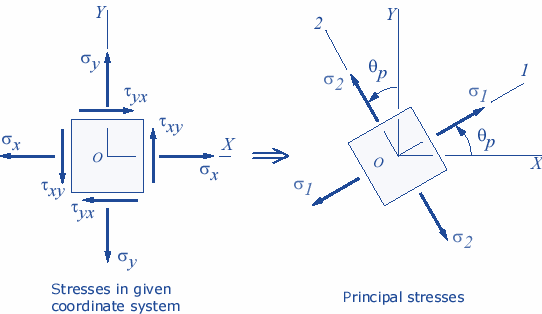
The angle ϴp where the shear stress τxy becomes zero.

The angle ϴp can be defined in the principal directions where the only stresses are perpendicular stresses. These stresses generated at these angle are called principal stresses and they are found from the original stresses (expressed in the x,y,z directions) via. Below is the principle stress formula or principal stress formula:

Another angle ϴs where the maximum shear stress occurs called as the maximum shear stress angle. This is found by finding the maximum of the shear stress transformation equation, and solving for ϴs. The result is,

From above we can say that, the optimum shear stress is equal to half the difference between the two principal stresses,

Maximum shear stress transformation can be illustrated as
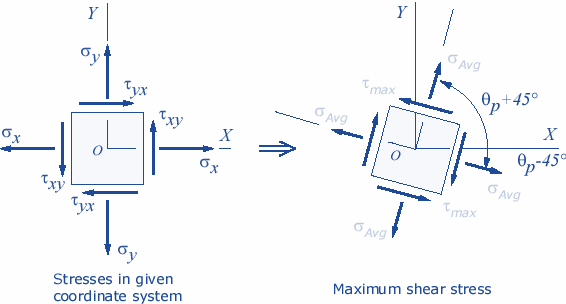
NCERT Physics Notes:
Shear Stresses in Fluids
Shear stresses in Newtonian fluids, a fluid at rest cannot resist shear (ideal fluids). Under the influence of force, it continuously deforms, no matter how small they may be. Resistance to shear forces in a fluid occurs only when the fluid is in motion. This implies the key difference between liquid and solid. For solids, the resistance to shear strain depends on the strain itself, i.e. the shear stress τ is depends on rate of shear strain γ. For liquids, shear stress is a function of strain rate dγ/dt. The property of a fluid to resist the development of shear strain is called viscosity.
The shape of the relationship between shear stress and strain rate depends on a fluid, and most common fluids obey Newton's law of viscosity, which states that shear stress is proportional to with strain rate:
τ =µ dγ/dt
Such a fluid is called a Newtonian fluid. The scaling factor µ is known as the dynamic viscosity and its value depends on the particular fluid. The dynamic viscosity divided by the density is called kinematic viscosity
ν = µ/ ρ
Also check-
Frequently Asked Questions (FAQs)
The unit of the stress is N/m2. It is defined as the internal resisting force per unit area.
Strain is the dimensional less quantity. It is defined as the ratio of the change in dimension to the original dimensions.
Strain is the ratio of two same quantities hence it is dimensionless.
Newton’s law of viscosity gives the relationship between the shear stress and strain rate in fluids.
τ =µ dγ/dt
Where τ is shear stress and dγdt is rate of shear strain and µ is viscosity.
Stress = Internal resisting force/crosssectional area
Strain = Change in dimension after deformation/Original Dimension
The occurrence of shear strain is called shear.